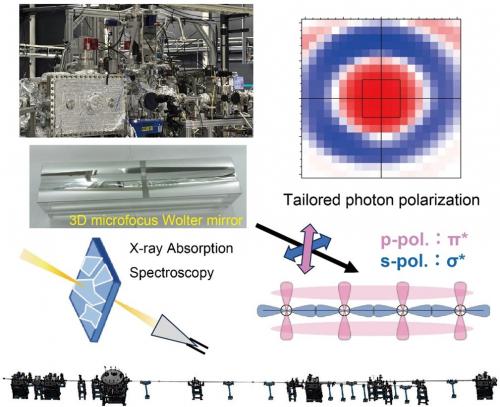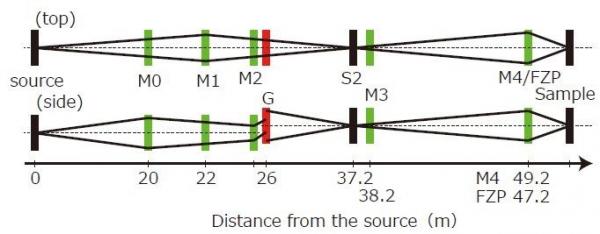ナノ吸収分光ビームライン/Nano absorption spectroscopy beamline

BL13Uは、X線吸収分光を用いて物質の構成元素、価数、配向、磁性などの性質を明らかにするビームラインです。軟X線からテンダーX線までの幅広いエネルギー領域(180~3000 eV)を用いることで、多くの元素を一度に観測することができます。試料上の放射光ビームサイズは装置によって数μmまで絞ることができ、細胞内部や磁石内の僅かに磁場の向きが異なる領域などの顕微サイズの情報を抜き出すことができます(顕微能力を10 nmオーダーまで向上させる装置開発も進行中)。BL13Uではこれに加えて、分割型挿入光源という特殊な光源を採用することで、複数の放射光を組み合わせてこれまで得られなかった特殊な偏光を持つ放射光を発生させ、測定に用いることができます。このビームラインで広エネルギー、顕微、偏光制御を組み合わせた測定環境を提供することで、物性物理から天文学、生命科学に至るまでの幅広い学術分野に新たな知見をもたらすことが期待されます。
BL13U is a beamline designed to unveil the fundamental properties of materials, including the constituent elements, valence, molecular orientation, and magnetic characteristics, by using X-ray absorption spectroscopy. A broad energy range, from soft X-rays to tender X-rays (180–3000 eV) is available at this beamline. This wide energy range allows for the simultaneous observation of various elements, providing a comprehensive view of complex samples. The beam size on the sample can be focused down to just a few micrometers, enabling the extraction of microscopic information from intricate structures, such as the detailed functionals within cells and magnetic domains in magnets (a new instrumentation with better spatial resolution, down to ~10 nm, is ongoing). Furthermore, BL13U adopts a unique segmented insertion device. This specialized light source allows us to combine multiple synchrotron radiation beams, generating unique polarization of beams.
By offering a measurement environment that integrates a wide energy range, high spatial resolution (microscopy), and versatile polarization control, BL13U is poised to deliver groundbreaking insights across a diverse array of scientific disciplines. We anticipate its impact will span from condensed matter physics and materials science to astronomy and life sciences, fostering new discoveries in each field.
Also see
- Ohtsubo et al. J. Phys. Conf. Ser. 3010 , 012079 (2025).
- Ohtsubo et al. J. Phys. Conf. Ser. 2380 ,012037 (2022).
- ビームライン説明資料 (利用研究課題募集要項より)
▶Main parameters of beamline(click to open)
| Insertion device | Segmented APPLE-II |
| Energy range and polarization | (Single segment) 180-1400 eV /circular (C) 180-3000 eV /linear horizontal (LH) 260-3000 eV / linear vertical (LV) (Four segments) 180-1400 eV / linear, arbitral orientation 260-3000 eV / circular |
| Relative resolving power (E/ΔE) | > 10000 @ 400, 865 eV (calibrated by N2 and Ne gas |
| Flux on sample | > 1011 photons / sec. (design value) |
| Beam size on sample | < 3 μm (μ-XMCD endstation (ES)) < 30 μm (Free port, focused beam) ~ 3 mm (Free port, non-focused beam) < 10 nm (nano-XAS ES, design value) |
▶Endstations (click to open)
Several endstations are ready for users at BL13U, depending on the target measurements.
μ-XMCD station
This station is designed for microscopic X-ray Magnetic Circular Dichroism (XMCD) and Linear Dichroism (XMLD) measurements under ultra high vacuum. Focused bean smaller than 3 μm is available at this station. Several probes (electron, photon, etc.) can be used to measure x-ray absorption. Operando measurement to apply voltage to the sample is also feasible.
| Beam size on sample | < 3 μm |
| Pressure (measurement chamber) | < 1E-6 Pa |
| Magnetic field on sample | < 160 mT (2D arbitral orientation) |
| XAS probes | Total electron yield (TEY) Partial fluorescence yield (PFY) Total fluorescence yield (TFY) X-ray excited optical luminescence (XEOL) |
| Sample temperature | 160 K ~ room temperature |

Typical data taken at this endstation.
Right) Magnetic domains of a SmCo5 magnet (dark and white area).
※ Sample is provided by S. Li, S. Sakai and T. Ueno (QST)
Left) XAS difference measured with circularly polarized beams at each domain (XMCD)

Flag-style sample plate.
Typically 10×10 mm2 (thickness < 2 mm) sample can be mounted.
Free ports
BL13U has free ports without any endstations. These ports are available for users who are planning to bring their own experimental setup. At the free ports, both the focused beam down to ~30 μm and unfocused beam whose footprint is ~ 3 mm are available.
Some instrumentations designed to use this free port are available for general users. Please find details here (in Japanese).

An user-brought instrument to measure X-ray ferromagnetic resonance (XFMR)
(A photo courtesy of T. Ueno, QST)
▶Segmented Undulator(click to open)
This unique insertion device consists of a series of 4 short undulator segments and 3 electromagnetic phase shifters between each segment. Each undulator segment has the APPLE-II type magnet configuration, providing the beam with linear horizontal (LH), linear vertical (LV), and circular (C) polarizations. The phase shifters tune the interfere condition of photons from each undulator segment and thus control the polarization of the exit beam [3, 4].
The segmented undulator provides wide range of energy with a variety of polarizations. The mixture of the left- and right-handed circular polarization results in the linear polarization with its electric field vector tunable to any orientations perpendicular to the beam axis, not limited to the horizontal and vertical directions. The interference between LH and LV is circular polarization. Since one can use the 3rd harmonics of the synchrotron radiation from each segment, wider energy range of circularly polarized beam is available at BL13U, comparing to the ordinal (non-segmented) APPLE-II-type undulators.
Practical performance of the segmented undulator is in commissioning [6]. This photon source becomes available for general users, hopefully soon.


(left) A picture of the segmented undulator at BL13U
(right) A schematic drawing of the segmented undulator

(left) Simulated spatial distributions of flux density and polarization of the synchrotron radiation beam from the segmented undulator. The 1st and 3rd (2nd and 4th) undulators are set to provide LH (LV) polarized beams.
(right) Simulated energy spectrum and circular polarization integrated in the dashed square in the left.
This simulation is performed by SPECTRA [5] and the figures above are from ref. [2].
References:
[3] T. Tanaka, Phys. Rev. Accel. Beams 17, 060702 (2014).
[4] I. Matsuda et al., e-JSSNT 17, 41 (2019).
[5] T. Tanaka, J. Synchrotron Rad. 28, 1267 (2021).
[6] K. Inaba, Y. Ohtsubo et al., in preparation
▶Beamline Optics (click to open)
The beamline optics is schematically depicted below. The varied-line-spacing plage grating (600 lines/mm) together with the pre-focus cylindrical mirror optics focuses the monochromatized beam on the exit slit (S2).
Detailed explanation and performance is shown in the references [1, 2].

Figure: Schematic diagram of the optical path and beam envelope of BL13U, reproduced from ref. [2].

* The data above is from ref. [1]
お問い合わせ
- BL13Uについて
量子科学技術研究開発機構 NanoTerasuセンター ビームライングループ
大坪 嘉之 E-mail: ohtsubo.yoshiyuki[at]qst.go.jp
- 共用ビームラインの利用について、こちら(Proposal Application)

